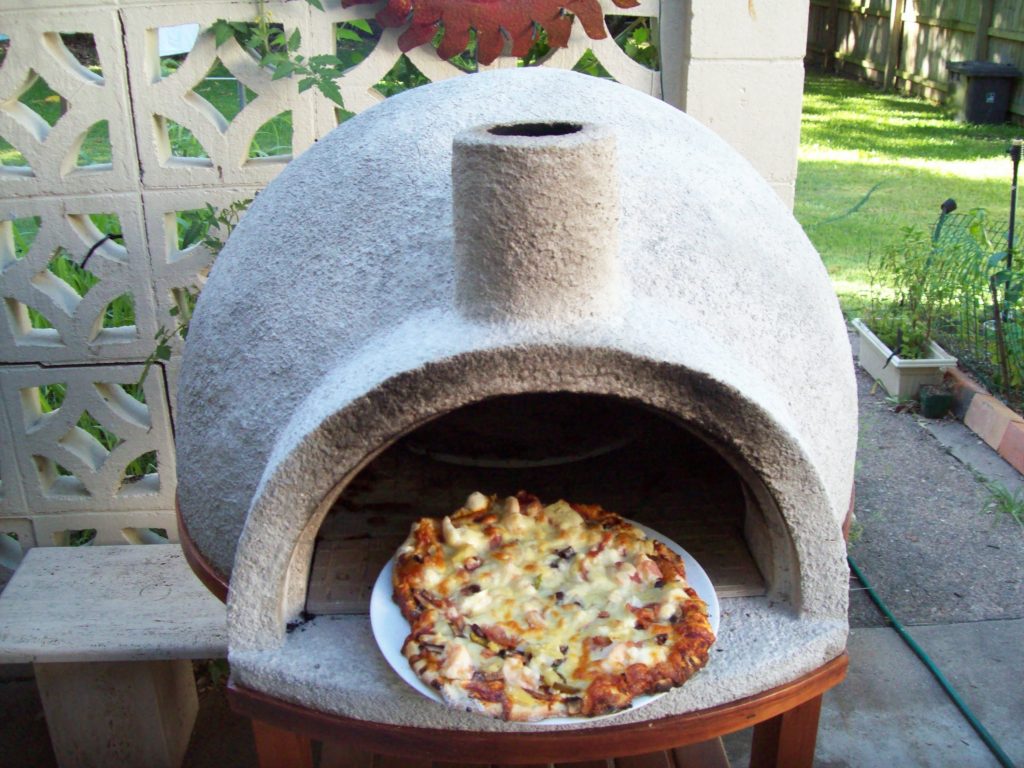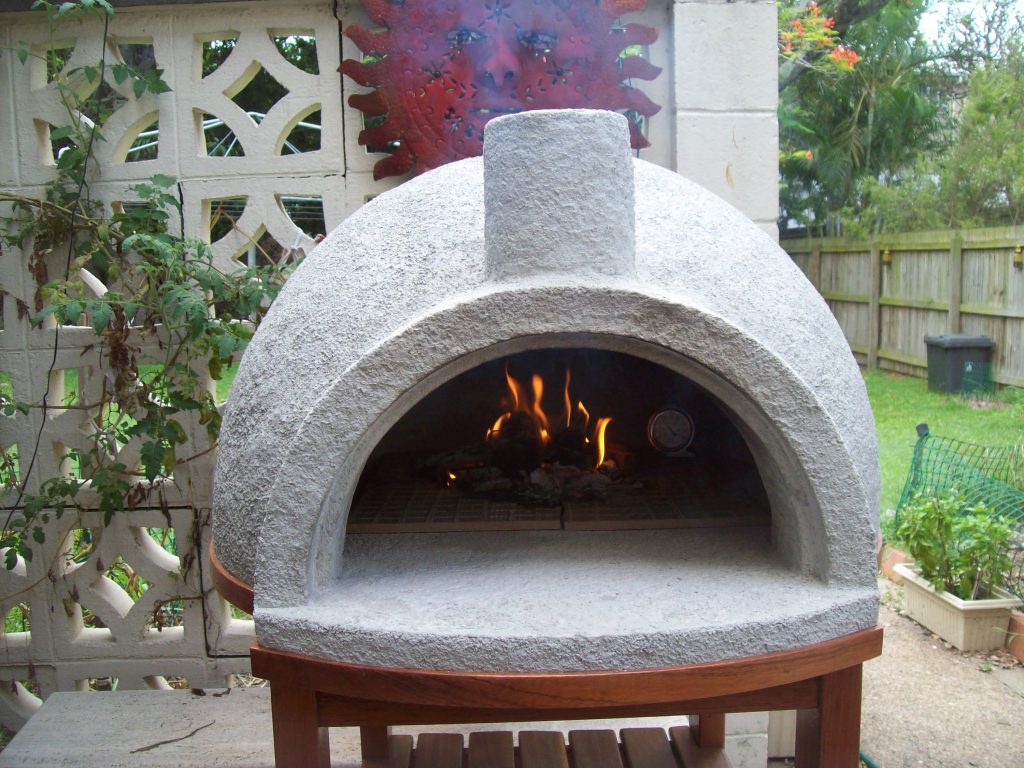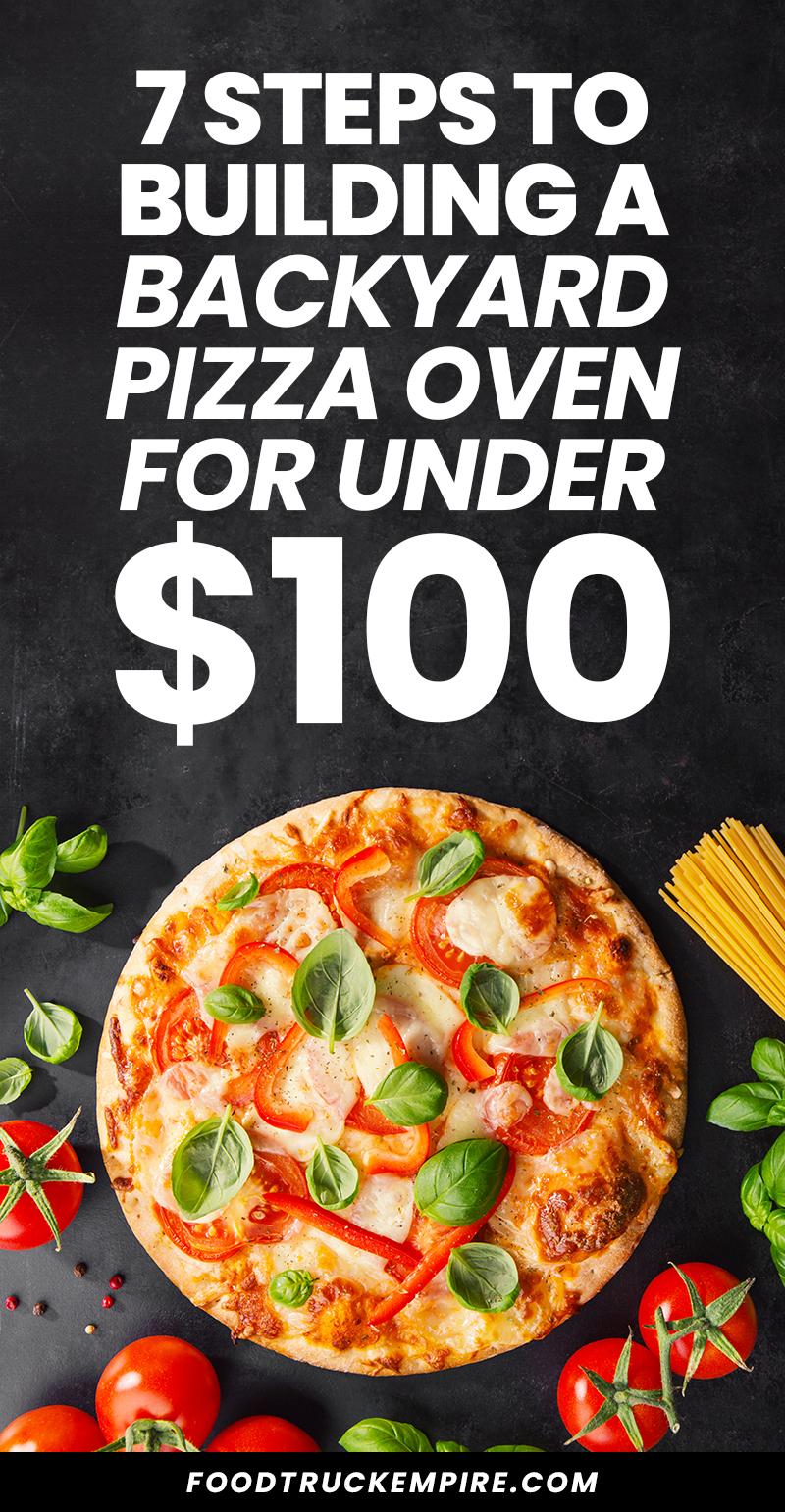We’ve got something a bit out of the ordinary from our regular posts: You’re going to learn the seven-step process to building your own wood fired pizza oven. If you’ve ever dreamed of being able to enjoy the wood-fire crust at anytime at home this is the project you’ve been waiting for.
Word of warning though… This pizza oven is going to take some sweat equity and a few days if not weeks to complete for most people. But for the DIY guy (or gal) with a burning desire for wood-fire pizza anytime, it’s the perfect project to invest your time and creativity toward.
Your reward for this all this effort is year’s of pizza eating bliss. Oh yeah, it’s totally going to be worth it.
While you will need to spend your time, you won’t need to spend much money to get this pizza oven built. With a bit of creativity you really can get this built for under $100. In the tutorial videos below, the pizza oven was built using reclaimed wood and other recycled materials. Even if you were to go out to the local hardware store to find some supplies, you should be able to keep the total cost well under $500. That’s less than the price of a slice of restaurant pizza per day over the course of a year to build your own oven!
A middle-school technology teacher Tom Peyton is in charge of creating this video series and documenting the process of building this oven. Peyton does a variety of cool builds like this to help inspire and educate his students about mechanics and industrial technology. Hat tip to everything you do to encourage the next generation of engineers, builders, and inventors! Check out Tom Peyton’s YouTube page to see what he’s building next.

Example of a backyard pizza oven.
Things To Consider Before Starting Your Pizza Oven Build Out
Before we dive into the step-by-step instructions on building an an, it’s important that you have a clear idea of the type of oven you want to end up with. We provide detailed instruction on how to build a small, portable pizza oven that’s moved on a small trolley. This oven is ideal for a beginner that wants to get a hang of build process and bake wood-fire pizza pies at home. If you’re feeling more ambitious and want a permanent masonry oven with a foundation made from brick, clay, and concrete then refer to the PDF plans located at the bottom of this article.
Space Requirements: How much space do you have? Do you want the oven to be movable or in a fixed spot? Make sure to answer these questions before starting a build out. Oven plans designed for restaurants can have a total hearth surface area of between 1,900 – 2700 inches. We recommend measuring the area you plan to build on to get a visual on what the build will look like first. Depending on where you live and if you have an HOA, you may need to seek a build permit before you start construction.
Cost: Generally speaking, the bigger the oven the more expensive the price. If this is your first oven build, our instructions will help you assemble an oven for under $100 in total cost using reclaimed wood and other recycled materials. But if your plans are for restaurant or other commercial purposes the price can balloon up to $10,000 for construction.
Tools & Materials: Again for our build you will need minimal tools and materials. As you graduate to more complex brick ovens you will require tools like a mallet hammer, fire bricks, fire clay, fire blankets, and other materials. Refer to your pizza ovens specific plans for a full list of equipment.
Small Pizza Oven Build (Our Example)
- Hammer
- Nails or screws (for trolley)
- Wheels / casters (for trolley)
- Gloves
- Mixing bag or bucket
- Plywood and 2 x 4’s.
- Bag of cement
- Bag of course Vermiculite
- Bag of fine Vermiculite
- Water
Personal Skill Level: Finally, you need to honestly access your personal skill-level before embarking on this project. Although anyone can build the skills needed to build a DIY oven overtime, if you’ve never built anything by hand before we recommend starting with a beginning oven as we describe in the videos below. If you want to complete something more ambitious, consider enlisting a friend or relative with more experience that’s interested in helping and can point you in the right direction when problems arise.

Learn how to build a pizza oven.
How To Build a Backyard Pizza Oven in 7 Steps
Although most people will build ovens like this with the goal of cooking a pizza pie, you’re certainly not limited to this type of food. Where you’ve got a flame, you can cook almost anything including baking bread, cooking fish, meats, or anything else you’d like to try. There are many different variations of oven plans you can find online as well that we’ve linked to near the bottom of this post if you want to go for a different style of build.
Ready to build your own backyard oven? Awesome! Closely follow the instructions provided in each of the videos below to get started.
Step 1: Constructing the Form of the Oven
The first step is to build the form for your pizza oven. The form on this example is very simple with plywood being used with up cuts for the four legs to keep the foundation off the ground slightly. A 60 liter fit ball was used for this example, but you can go larger if you would like. The build is these videos is for a medium sized oven. A bigger ball means a bigger oven at the end of the process!
An affordable fit ball like this that you can purchase off of Amazon for under $20 is the ideal shape to create the dome of the oven. This part of the oven is also called an igloo due to it’s shape.
Next you can see what will make the arch of the oven. The arch is the semi-circle opening to the pizza oven. Again, reclaimed plywood and 2 x 4’s are used for this section. We simply rest this piece alongside the fit ball. There is a recess built into this area door of the oven as well.
For this oven build, the top of the dome is approximately 100 cm high. The middle of the arch is about 56 cm. As a general rule of thumb, the arch should be about two thirds the height of the dome.
After form has been constructed, it’s time to cover the structure with a plastic wrap. You can take the plastic wrap straight out of the package and completely cover your oven. We recommend you start by covering the dome area and then move to the arch. Be sure to pat down and smooth out the plastic wrap as you complete this step.
After the oven has been wrapped, it’s time to create the form of the chimney. To create the form of the chimney you can use a recycled 20 oz. soda bottle to create the round shape as demonstrated in the above video. You will also use a small piece of board to hold the chimney form in place. This will be attached to the top of the oven and provide ventilation when cooking.
After you’ve completed this step, it’s time to take a break and congratulate yourself. By the time you finish up with video two, you’ll have a unit that much more closely resembles an actual backyard pizza oven.
Step 2: Building the Oven Shell
In this section, we will be creating the oven wall. Three ingredients will be needed to create this sturdy wall oven:
Vermiculite: Vermiculite is a mineral that’s often used as a cheap insulator making it the ideal material for pizza ovens. It’s often described as having similar qualities to Perlite. Usually vermiculite is used for planting so you can find vermiculite in a lot of stores including home and garden stores, Wal-Mart, and of course Amazon.
There different types of vermiculite too! There are coarse and fine grade varieties available. If you use finer vermiculite, you are able to achieve a smoother and stronger wall finish.
Cement: You can get cement mix affordably at your local Home Depot or Lowe’s. This will typically run you about $8 per square foot. As you already know, cement is not the main ingredient in our oven wall so you should be all in at under well under $30 for this piece.
Water: Feel free to use good old fashioned unfiltered tap water for this project.
The ratio for our oven wall will be 5 parts vermiculite (3 parts coarse, 2 parts fine), 1 part cement, 1 – 2 parts water depending on how everything is binding.
You will need a large bucket, tub or mixing bag to stir vermiculite, cement, and water mixture. If you can find a small shovel or mixing stick that would be ideal in this process. You’ll want to continue stirring this mixture until you’ve got a nice even mix between the cement and vermiculite. Continue to add water until the mix begins to bind.
Depending on how the mix looks, you may need to continue adding more water until the material binds.
Building Up the Wall with the Mix
After the mix is made, it’s time to start applying the wall layering to our oven form. To accomplish this you’ll want to start at the bottom of the form and begin to slowly work your way around and up the mold.
It’s important as you apply the mix to ensure that the wall layering is a consistent level of thickness all the way around the oven walls. For this medium sized oven the wall thickness will be roughly 20 mm or .78 inches. If you’re making a larger size oven, you will of course need to increase the thickness of the walls.
This part of the project can be done in batches as well. Feel free to let the lower layers of the wall set overnight if needed and continue moving forward the next day or when you have time. All you need to do from this point is to simply continue the process of adding to your oven wall consistently and then allowing time for it to set and dry.
Step 3: Building the Trolley
In this step, a trolley has been built to more easily transport the pizza oven. Wood from old pallets were reused primarily to build this trolley so finish is not as pristine as if you used 100% new material. Four casters were installed on the unit for easier mobility.
A large sheet of 5 mm plywood will be positioned at the top of this trolley where the oven’s shell will ultimately be placed. This is a quick step compared to others inside this tutorial!
Step 4: Building the Oven Floor and Door
This video starts where the last video in the series left off by sanding down the trolley so it’s smooth and installing the oven’s floor. As you see an electric drill was used to quickly install the screws into our trolley for support.
Originally the plan was to use a sand floor for the oven. Sand certainly could work well, but it would also result in a very heavy oven that would be difficult to move around. Instead the oven floor will be made from vermiculite just like the oven. As you can see in the 1 minute, 35 second point of the video, a form has been created for the floor using Corex / Corflute at 60 mm in height. Small nails were placed around the oven floor to support the Corex / Corflute.
With this build, we need the floor to absorb and prevent heat from going down to the wooden base of the pizza oven. The 60 mm vermiculite floor depth should be sufficient to prevent this from happening.
Important Note:
Oven Floor Mix: The insulation mix will change slightly for the floor of the oven. Use 5-parts course vermiculite, 1-part cement, and 2 parts water for the floor oven. You can mix this evenly within the same bucket or cement bag you used previously.
Oven Door Mix: 5 parts medium vermiculite, 1-part cement, 2 parts water. You can use the exact same method as previously described to make the form of the oven door. When you’re laying the mix for your oven door, be sure to insert some type of metal and sturdy handle that will be used to open and close your oven. You can add any metal handle that is sufficiently sturdy and fits the style of your oven.
Watch the video above to see the time lapse of the oven floor and door mix being installed.
Step 5: Assembling the Floor and Pizza Oven into the Trolley
Thanks to the magic of time lapse video, the pizza oven and floor has been set! In this video you’ll learn how to set the oven and floor on the trolley. Once you get the floor and oven on your trolley you may notice some cracks in your creation. Not to worry! A product called Vesuvius can help you fill in any cracks that occur. This product is also used to mortar and connect the oven shell to the floor. Be sure to allow 6 – 8 weeks minimum for the oven to set at this point. With that being said, we are getting very close to completing this oven build! Congratulations on making it this far! Note: If you’re worried about the appearance of the oven at this point, don’t be. The oven will be smoothed out to be more attractive in appearance soon.
Step 6: The First Fire In Your Home-Made Oven
Although the build has been completed there’s still a bit more work that needs to be done before actually sliding the first pizza pie into this oven. You need to break it in first! The first time you use the pizza oven you will want to start a small fire like the one demonstrated in the video and let the oven burn for about 15 minutes. Make sure that your first fire isn’t too big as it may crack the shell.
After you’ve had a successful first burn, wait a few days and complete a final test fire that runs for around 30 minutes. Again, make sure that the fire is not too large and intense as it may crack your oven shell. In the final video, we will be working on installing the oven chimney.
Step 7: Installing the Chimney
In this video, we will be fitting the flue AKA installing the stainless steel chimney to allow for ventilation in the oven. The first step in the installation process is the block the chimney hole with wood and some cardboard so you can drop the chimney into the top. A refractory cement called Vesuvius was used to install this chimney, but you could use any fire cement. Make sure the refractory cement is of a thick consistency so that it doesn’t slide down into the chimney. Try to shove as much of this cement as possible to ensure the chimney is supported.
After the cement is set, a copper flashing is being installed all the way around the chimney. This will stop the chimney from moving down inside the oven over time. At this point the build is complete and the oven is ready to start cooking pizza!
More Free DIY Pizza Oven Plans & PDFs
Looking for more advanced pizza oven plans than the one made inside our video series? Check out the links below that will take you to some of the best build outs in PDF that we’ve been able to compile online.
How to Build a Pizza Oven in Four Days – Ready to graduate from small DIY pizza ovens like we went through in the video tutorial? If your goal is to build a permanent pizza oven in your backyard this is a terrific outline on how to accomplish with photos. This will require a solid cement foundation and significantly more expense than the video tutorial listed here.
My Pizza Oven Construction Guide PDF – This is an awesome 40-page guide you need to read if you are considering a permanent backyard pizza oven build. The illustrations and photographs in this guide make it a joy to read and you can tell how much work .
This PDF goes into a lot of detail into building the foundation of your pizza oven. Building a solid foundation isn’t a big deal when building a medium sized oven such as the one we demonstrated, but it’s an extremely important subject when it comes to larger brick ovens. This oven’s dimensions are 1200 mm x 1200 mm x 300 mm.
Outdoor Pizza Oven Plans – Terrific illustrations of different components of the build process, including views of the arch and oven door that aren’t readily available elsewhere. You can also find a helpful list of materials and specific tools needed to accomplish this build.
How to Build a Pizza Oven – Extremely in-depth piece that outlines different material options, dimensions, along with how-to instructions for using the oven and providing on-going maintenance.

We hope you’ve enjoyed this epic post on building your first pizza oven. As you can see from the videos, completing this project is no easy feat and will require weeks of consistent effort to accomplish. If you end up making your own pizza oven, please share those photos and stories in the comments section below! We look forward to seeing your DIY pizza ovens.




